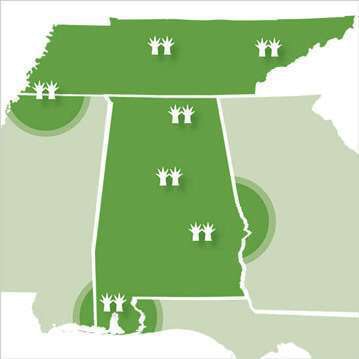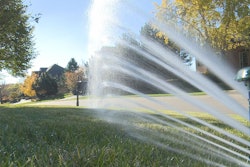
 Landscape Workshop serves only commercial clients, including this shopping center in Birmingham, Alabama, where the 30-year-old company is based.
Landscape Workshop serves only commercial clients, including this shopping center in Birmingham, Alabama, where the 30-year-old company is based.Photo: landscapeworkshop.com
In boasting of its expertise in mowing grass properly, with attention to the turf’s health as well as appearance, Landscape Workshop isn’t soliciting residential customers. It serves only commercial clients in its neck of the deep South, and it’s to them the company presents not only an impressive portfolio of major design-build projects but also testimonials to its knowledge of how to maintain grass properly.
 In addition to Birmingham, Landscape Workshop has Alabama branches on the Gulf Coast, in Foley, one serving the Montgomery-Auburn corridor and another in Huntsville, as well as three branches in neighboring Tennessee: Knoxville, Memphis and Nashville. From those locations, the company also serves clients in Georgia, Mississippi and the Florida panhandle.
In addition to Birmingham, Landscape Workshop has Alabama branches on the Gulf Coast, in Foley, one serving the Montgomery-Auburn corridor and another in Huntsville, as well as three branches in neighboring Tennessee: Knoxville, Memphis and Nashville. From those locations, the company also serves clients in Georgia, Mississippi and the Florida panhandle.Graphic: landscapeworkshop.com
Landscape Workshop believes “improper mowing is actually one of the most common causes of people being dissatisfied with their property’s landscaping,” the company says on its website, and its review of the fundamentals of grass maintenance is a good refresher for landscape workers.
First and foremost is knowing how and when to mow based on two key facts: the grass type and the growing season.
“The grass type determines how tall the grass should be before it’s cut, as well as the height you want to trim it down to when mowing,” says Landscape Workshop. “Grasses are also divided into two categories (cold and warm-season grasses) that describe their growth cycle throughout the year. For example, a warm-season grass, such as Bermuda, will grow faster and need to be cut more frequently when it’s warm outside.”
And as you may have preached in conversations with clients, it’s extremely important not to cut grass too short. Remind them why, advises the company – how it increases vulnerability to pests, disease and weed germination, as well as damage by heat, cold and drought.
Landscape Workshop says it’s equally important to keep the grass from getting too long, mainly because it will clump together.
Then there’s these mowing no-no’s
Another familiar rule: “(N)ever cut more than one-third of the grass-blade height at once.” That and the imperative of sharp mower blades may be elementary, but did you know dull blades affect the health of the grass?
 While designing, building and maintaining commercial landscapes such as this one at a retail center in Knoxville, Landscape Workshop says it never takes for granted the importance of mowing its clients’ grounds.
While designing, building and maintaining commercial landscapes such as this one at a retail center in Knoxville, Landscape Workshop says it never takes for granted the importance of mowing its clients’ grounds.Photo: landscapeworkshop.com
“When mower blades get dull,” Landscape Workshop says, “they rip the leaf tissue of the grass blade … As a result, the grass does not heal properly, which causes frayed grass blades that can give the grass an overall brown look for several days after mowing. Not only is this visually unappealing, but it also leaves your grass more vulnerable to pests, diseases and heat stress due to loss of moisture.”
Uniformity in the cutting path is another no-no for the reason you can guess (if you don’t know): “Mowing patterns and the repeated passage of the mower’s wheels can cause the soil to compact and create ruts … which can become quite visible over time. By mowing in different directions, the soil will remain even and the grass will be able to grow upright instead of leaning in one direction.”
And finally, there is, according to Landscape Workshop, never a good reason to cut grass before it’s dry. If your crew schedule demands it, you’re going to pay a price on several fronts, including the appearance, of course, but also increased wear and tear on your equipment and a safety hazard in areas that must be handled by a walk-behind.
Along with grounds maintenance, including tree and floricultural care, Landscape Workshop provides design, construction, enhancement, irrigation, pest management and facilities management services, including snow and ice control.










